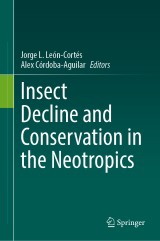Details

Insect Decline and Conservation in the Neotropics
|
171,19 € |
|
| Verlag: | Springer |
| Format: | |
| Veröffentl.: | 21.04.2024 |
| ISBN/EAN: | 9783031492556 |
| Sprache: | englisch |
Dieses eBook enthält ein Wasserzeichen.
Beschreibungen
<p>This book provides for the first time an integrative analysis of the major drivers of decline and threats of insects and related arthropods in the Neotropical region. Thus, it is an urgent first step towards filling an information gap in this region. It identifies the main causes of decline, provides and discusses examples from the better-studied insect faunas to develop and advance principles and practical conservation management for the rich Neotropical insect faunas. </p>
<p>The book is aimed at students, naturalists, environmental managers, and others who have training in entomology/insect ecology and can apply the results of surveys of key insect faunas to assess their vulnerability to environmental change and establish guidelines for their conservation.</p><br>
<p>The book is aimed at students, naturalists, environmental managers, and others who have training in entomology/insect ecology and can apply the results of surveys of key insect faunas to assess their vulnerability to environmental change and establish guidelines for their conservation.</p><br>
<p><b>Part I. Introduction.- </b>Chapter 1. Conservation and Threats That Insects Face in the Neotropics.- <b>Part II. Stressors of Decline on Selected Taxa.-</b> Chapter 2. Habitat Fragmentation and Insect Biodiversity Change in Mexican Landscapes.- Chapter 3. Neotropical Wasps: Identifying Trends and Gaps for Their Conservation.- Chapter 4. Arachnids at the Edge: View and Perspectives, with Emphasis on Spiders and Scorpions.- Chapter 5. Declining Dung Beetle (Coleoptera: Scarabaeidae) Abundance and Diversity in the Neotropics: Causes and Conservation Strategies.- Chapter 6. Monarch Butterfly Forest Occupation at the Mexican Overwintering Sites: A New Reality.- Chapter 7. Habitat Loss and Fragmentation in Chaco Forests: A Review of the Responses of Insect Communities and Consequences for Ecosystem Processes.- Chapter 8. Urban Insect Communities in the Neotropics: A Systematic Literature Review and a Green Path to Promote Biodiversity Conservation.- Chapter 9. Insect Diversity Changesin Mexican Agro-Landscapes.- <b>Part III. Decline and Conservation of Insects in Neotropical Biodiversity Hotspots.-</b> Chapter 10. Fruit-Feeding Butterfly Assemblages: Trends, Changes, and the Importance of Monitoring Schemes in Neotropical Environments.- Chapter 11. Diversity and Conservation of Mesoamerican Bees: Relative Effects of Three Major Threats Within the Potential Distribution of Bee Species.- Chapter 12. Threats to Ant Diversity in Mesoamerica.- Chapter 13. The Role of Endemism and Biodiversity Hotspots In Conservation: A Case Study with Neotropical Leaf Litter Weevils.- Chapter 14. Natural History Collections as Resources for Assessing Biodiversity Hotspots and Insect Declines: Case Studies, Opportunities and Challenges.- Chapter 15. Biodiversity of Aquatic Insects in the Neotropics: Perspectives and Challenges.</p>
<p><b>Jorge L. León-Cortés</b> is a senior ecologist working on insect conservation, population dynamics, and landscape ecology, with an international publication record in entomology, insect ecology and biodiversity conservation. He is Co-Editor-in-Chief of the Journal of Insect Conservation, reviewer of several relevant ecological and conservation journals and Coeditor of the book ‘Biodiversity and Conservation of the Yucatán Peninsula’ (2015, Springer).</p><div><p><b>Alex Córdoba-Aguilar</b> is a senior ecologist working on insect conservation, behavior, physiology and evolution, and insect vector control. He is author of over 150 scientific papers and coeditor of three books (e.g. Insect Behavior: from mechanisms to ecological and evolutionary mechanisms). He serves as editorial member of the following journals: Ecological Entomology, Acta Tropica and Odonatologica.</p></div>
<p>This book provides for the first time an integrative analysis of the major drivers of decline and threats of insects and related arthropods in the Neotropical region. Thus, it is an urgent first step towards filling an information gap in this region. It identifies the main causes of decline, provides and discusses examples from the better-studied insect faunas to develop and advance principles and practical conservation management for the rich Neotropical insect faunas. </p><p>The book is aimed at students, naturalists, environmental managers, and others who have training in entomology/insect ecology and can apply the results of surveys of key insect faunas to assess their vulnerability to environmental change and establish guidelines for their conservation.</p>
Provides an integrative analysis of the main drivers of insect decline in the Neotropics Summarizes lessons from case studies, and discusses insect protection regulations based on a country-based analysis Discusses examples from among the better-studied insect faunas regarding the main stressors of decline
Diese Produkte könnten Sie auch interessieren:

The Vicuña

von: Iain Gordon, Jane C. Wheeler, Hugo Yacobaccio, Jerry Laker, Marcelo Cassini, Mariela Borgnia, Yanina Arzamendia, Verónica Benítez, Bibiana Vilá, Cristian Bonacic, Jessica Gimpel, Pete Goddard, Desmond McNeill, Gabriela Lichtenstein, Renaudeau d' Arc Nadine, Kristi Anne Stølen, Javier García Gomez, Ana Wawrzyk

96,29 €

Saving Biological Diversity

von: Robert A. Askins, Glenn D. Dreyer, Gerald R. Visgilio, Diana M. Whitelaw

96,29 €

Martens and Fishers (Martes) in Human-Altered Environments

von: Daniel J. Harrison, Angela K. Fuller, Gilbert Proulx

149,79 €













